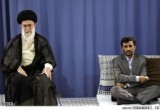
Brought to you from Voice of Balatarin
No matter what Iranians thought about the Islamic Republic of Iran, its Supreme Leader Seyed Ali Khamenei, and its president Mahmoud Ahmadinejad before the June 12, 2009 election, there remained few Iranians who did not re-think and re-evaluate those opinions after the week-long protests that followed the announcement of election results, the street protests, the violence, and the historical sermon delivered by Seyed Ali Khamenei during the Tehran Friday Prayer on June 19, 2009. To be sure, Ayatollah Khamenei’s endorsement of the election results, his emphatic support of Mahmoud Ahmadinejad–not only as the winner, but the candidate closest to his own way of thinking–and his clear promise of a brutal crackdown on further protests, re-introduced him to the nation, and brought on unprecedented anger against him, an anger which does not seem to have subsided, based on slogans chanted on the streets and comments written on Balatarin. Iran changed during that election week in 2009; it is possible to say that the two top casualties of the post-election events were Iran’s Supreme Leader and the Islamic Republic of Iran as a political system. Nobody suffered a bigger damage to his name, office, and reputation as did Ayatollah Seyed Ali Khamenei, the Supreme Leader of Iran.
That endorsement and the systematic violence of the past two years, whether on the streets, in courts, in prisons, or on university campuses, have tied Iran’s Supreme Leader and Mahmoud Ahmadinejad together forever. In fact, news of the growing rift between Mahmoud Ahmadinejad and the Supreme Leader initially met ambivalent reactions from some Balatarin users, who suspected the feud to be staged and fake, intended to deflect attention from the growing economic problems and the continuing discontent. But the rapidly developing events of the past few days indicate that despite the Supreme Leader’s repeated denials, there may be truth to the rumors.
In what has been dubbed as “MoslehiGate,” in a span of a few days, it was first announced that Iran’s Minister of Intelligence, Heydar Moslehi’s resignation had been accepted Monday, April 18. The next day, it was announced that Iran’s Supreme Leader had not only re-instated Moslehi, he asked him to double his efforts in his position. Moslehi was, however, not invited to the cabinet meeting on that same day. At the next meeting, however, Moslehi did show up, only this time, Mahmoud Ahmadinejad did not attend the meeting! At this time, there are also rumors about Mahmoud Ahmadinejad’s not having shown up to work at his office for the past week, seemingly to protest the reinstatement of a minister he had dismissed. In fact, over the past years, Mr. Khamenei has repeatedly imposed his will on Iran’s presidents and the parliament, against the Iranian Constitution and to the detriment of those offices and positions, but his decisions have never been resisted or challenged in the past. As what amounts to political gossip leaks out about Mahmoud Ahmadinejad’s absence from his office for several days and statements he made during a meeting with members of the Tehran City Council are reported, it appears that Mahmoud Ahmadinejad’s resentment and his resistance to the imposed decisions are quite real.
Whatever is happening, for the first time since the 2009 election almost two years ago, the top leaders of Iran no longer appear as the team that they were immediately following the election. As the power structure polarizes further and new lines are drawn in the sand, the average Iranians take breaks in their daily struggles with a deteriorating economy to amuse themselves with the developing new landscape of Iranian politics.
Until next time, stay with us and let the dialogue grow!
Visit Voice of Balatarin, where you could read these recent blogs:






